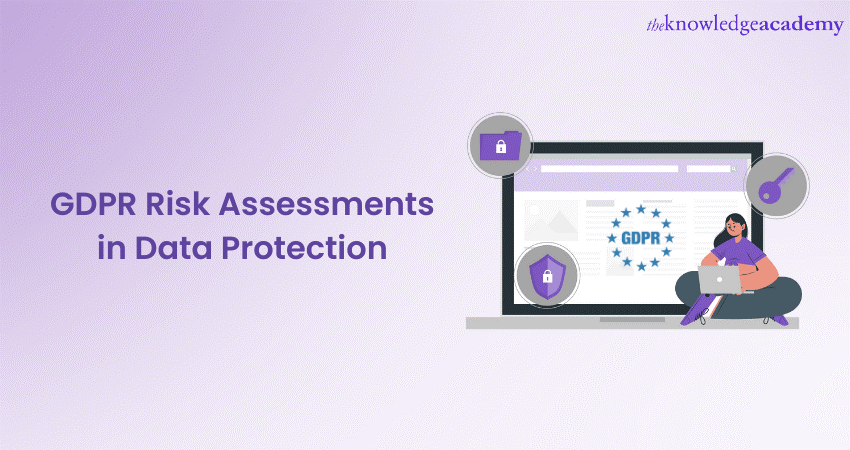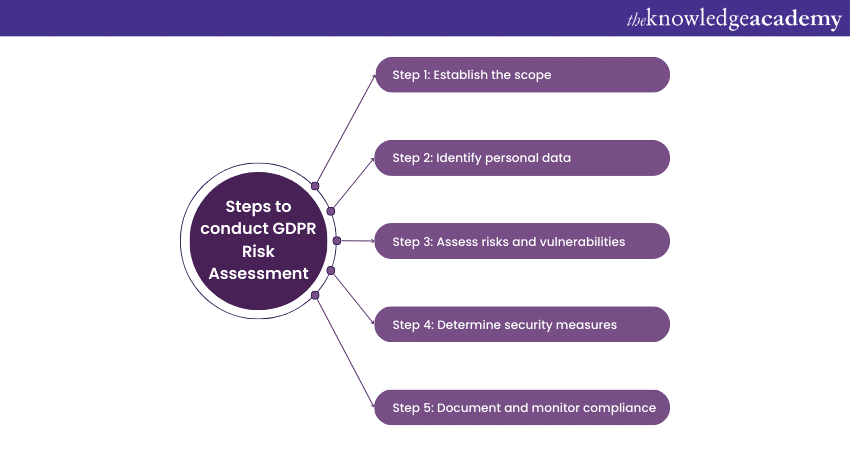We may not have the course you’re looking for. If you enquire or give us a call on 01344203999 and speak to our training experts, we may still be able to help with your training requirements.
Training Outcomes Within Your Budget!
We ensure quality, budget-alignment, and timely delivery by our expert instructors.

In the digital age, where Personal data is collected and stored extensively, safeguarding individuals' privacy has become paramount. The General Data Protection Regulation (GDPR), implemented by the European Union (EU), serves as a legal framework that sets out rules and guidelines for organisations to protect sensitive data. One of the fundamental aspects of its compliance is conducting GDPR Risk Assessments, often an integral part of the broader GDPR Audit process. The process of locating, examining, and assessing risks and vulnerabilities in Data Protection is known as GDPR Risk Assessment
With the rise of data breaches and privacy concerns, The Main Reason for GDPR Principles has become a crucial framework for organisations to protect personal data. According to Statista, one of the highest fines imposed on an organisation for violating a GDPR rule – insufficient legal ground for processing data – was almost £4,295,452.87.
Table of Contents
1) What is GDPR Risk Assessment?
2) Why are Risk Assessments by GDPR essential?
3) GDPR Risk Assessment methodologies
4) A step-by-step guide to conduct GDPR Risk Assessments
5) Tools and resources for Risk Assessments by GDPR
6) Conclusion
What is GDPR Risk Assessment?
A GDPR Risk Assessment is a process of identifying, analysing and evaluating the potential threats and vulnerabilities that may affect the Personal data of individuals in the European Union. A GDPR Risk Assessment helps organisations comply with the GDPR regulations, which aims to protect the privacy and security of Personal data. It also helps organisations to implement appropriate measures to reduce the risks and to demonstrate their accountability and transparency.
It is also required for the processing of Personal data that might put an individual's rights at high risk. This includes some specific types of data processing avanues, such as using new technologies, tracking people's location or behaviour, monitoring public places, processing sensitive Personal data, or making automated decisions.
Sign up for GDPR Training Courses today and ensure your organisation stays compliant!
Why are Risk Assessments by GDPR essential?
Risk Assessments by GDPR are significant in the context of Data Protection. These evaluations are crucial in helping organisations identify and mitigate potential risks to the Personal data they process. Organisations can proactively address vulnerabilities, ensure compliance, and strengthen their overall data security posture by conducting a thorough evaluation. Here are some key reasons why Risk Assessments by GDPR are essential:
a) Compliance with GDPR: Benefits of GDPR imposes strict obligations on organisations to protect Personal ata and ensure individuals' rights are respected. Conducting regular risk evaluations helps organisations meet their compliance requirements under the regulation. By identifying and addressing risks, they can demonstrate their commitment to Data Protection and minimise the likelihood of non-compliance.
b) Mitigating data breach threats: Risk Assessments by GDPR enable organisations to identify vulnerabilities in their data processing activities that could lead to know what is a gdpr breach. By addressing these possible threats, they can implement appropriate security measures and reduce the likelihood of data breaches.
c) Enhancing data security: These evaluations provide organisations with a comprehensive understanding of their data processing activities and associated risks. This knowledge enables them to implement robust security measures tailored to their needs.
By implementing appropriate technical safeguards, organisations can enhance data security, protect against unauthorised access, and reduce the risk of data breaches.
d) Efficient resource allocation: Conducting risk evaluations allows organisations to allocate their resources effectively. By identifying and prioritising risks, they can focus their efforts and investments on the areas that require immediate attention. This targeted approach ensures that resources are utilised efficiently.
e) Continual improvement: GDPR Risk Analyses are an ongoing process. Regular evaluations help organisations monitor and evaluate the effectiveness of their Data Protection measures and identify areas for improvement. By continually assessing threats, organisations can adapt to threats and regulatory changes makes the main Challenges of GDPR. ensuring that their data protection practices remain up to date.
GDPR Risk Assessment methodologies
A consistent and clear set of rules for conducting and interpreting the Risk Assessment is essential for any information security Risk Assessment methodology. This ensures that the risks are evaluated in a uniform way, which helps to prioritise them effectively.
A GDPR Risk Assessment can be done by following standardised methodologies that include:
1) Baseline security criteria: The basic level of defences to protect against risks.
2) Risk scale: A common way of measuring risk.
3) Risk appetite: It refers to the amount of risk an organisation is willing to overlook.
4) Scenario- or asset-based risk management: The strategies to minimise the impact of certain incidents or that can affect certain parts of the organisation.
A step-by-step guide to conduct GDPR Risk Assessments
By following a structured approach, organisations can effectively assess their data processing activities, identify potential vulnerabilities, and implement appropriate measures to mitigate threats. Here are the key steps involved in while conducting a GDPR risk evaluation:

Step 1: Establish the scope
The first step involves defining the GDPR Scope of the risk evaluation. You must determine the specific data processing activities, processes, and systems that will be included in the analysis. Then, you must consider the types of Personal data being processed, their purpose, and any third parties involved in the data processing chain.
Step 2: Identify Personal data
The second step is to identify and document the Personal data being processed by the organisation. This includes understanding the categories of Personal data, its source, and the recipients to whom it is disclosed. Consider structured and unstructured data stored in physical and digital formats.
Step 3: Assess risks and vulnerabilities
The third step evaluates the potential risks and vulnerabilities associated with data processing. Identify threats such as unauthorised access, data breaches, loss, or corruption. You must consider the impact and likelihood of each threat, considering factors such as the sensitivity and volume of the data.
Step 4: Determine security measures
Based on the identified threats, determine the appropriate security measures to mitigate them. This may include taking technical steps such as encryption, access controls, data anonymisation and organisational measures such as policies, training, and awareness programs. Consider the "Privacy by Design and Default" principle when selecting and implementing security measures.
Step 5: Document and monitor compliance
The final step involves documenting the risk evaluation outcomes, including the identified threats, vulnerabilities, and the corresponding security measures. Develop a risk register or similar document to record and track the evaluation findings. It is essential to establish monitoring mechanisms to ensure ongoing compliance with the identified security measures and to detect and address any new threats or vulnerabilities that may arise.

Tools and resources for Risk Assessments by GDPR
GDPR Requirements like risk evaluations,data processing are need to conducted frequently. To facilitate this process, organisations can leverage various tools and resources that assist in the efficient and effective execution of evaluations. Let's look at a few key tools and resources that can be utilised:
a) GDPR assessment templates: These templates provide a structured framework for conducting risk evaluations.
b) Data mapping and inventory tools: Data mapping and inventory tools help organisations understand the flow of Personal data within their systems and processes.
c) Privacy Impact Assessment (PIA) tools: PIA tools aid in evaluating the impact of data processing activities on individuals' privacy rights and identifying associated threats.
d) Data Protection Impact Assessment (DPIA) templates: DPIA templates assist organisations in conducting evaluations specifically focused on high-threat data processing activities.
e) Regulatory guidance and best practice documents: Regulatory authorities and industry associations provide guidance and best practice documents related to GDPR compliance and potential threat evaluations.
Gain in-depth knowledge and practical skills to navigate the complexities of GDPR compliance with our Certified EU General Data Protection Regulation (EU GDPR) Practitioner Course now!
Conclusion
Risk evaluations by GDPR contribute to enhancing data security as they provide organisations with a comprehensive understanding of their data processing activities and associated risks. We hope this blog has improved your knowledge of GDPR Risk Assessments.
Increase Data Privacy awareness within your organisation by registering for our Data Privacy Awareness Course now!
Frequently Asked Questions
Upcoming IT Security & Data Protection Resources Batches & Dates
Date
 Certified EU General Data Protection Regulation (EU GDPR) Foundation and Practitioner
Certified EU General Data Protection Regulation (EU GDPR) Foundation and Practitioner
Tue 7th May 2024
Sat 25th May 2024, Sun 26th May 2024
Mon 8th Jul 2024
Sat 14th Sep 2024, Sun 15th Sep 2024
Mon 23rd Sep 2024
Mon 18th Nov 2024
Sat 7th Dec 2024, Sun 8th Dec 2024







 Top Rated Course
Top Rated Course


 If you wish to make any changes to your course, please
If you wish to make any changes to your course, please


